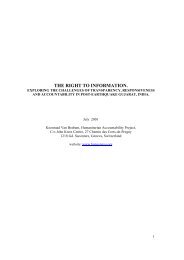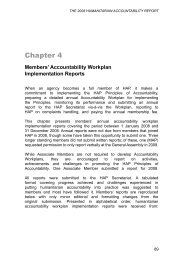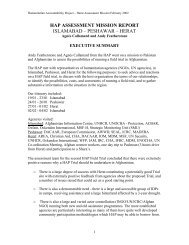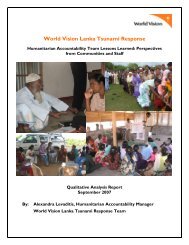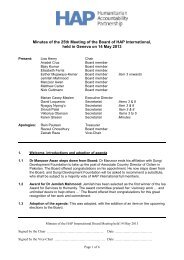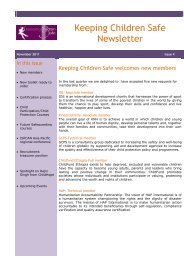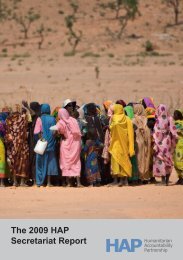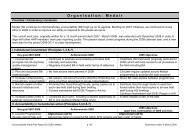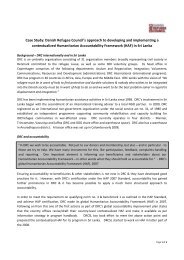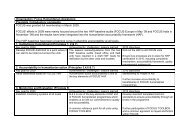HAP Guide to Certification - HAP International
HAP Guide to Certification - HAP International
HAP Guide to Certification - HAP International
You also want an ePaper? Increase the reach of your titles
YUMPU automatically turns print PDFs into web optimized ePapers that Google loves.
<strong>HAP</strong> <strong>Guide</strong> <strong>to</strong> <strong>Certification</strong><br />
9 November 2011
CONTENTS<br />
ABOUT THIS MANUAL ....................................................................................................... 4<br />
BACKGROUND ................................................................................................................... 5<br />
<strong>HAP</strong> <strong>International</strong> .......................................................................................................... 5<br />
Accountability ................................................................................................................ 5<br />
The <strong>HAP</strong> Standard and <strong>Certification</strong> .............................................................................. 6<br />
<strong>HAP</strong> Services ................................................................................................................ 7<br />
Working Collaboratively ................................................................................................. 8<br />
THE <strong>HAP</strong> CERTIFICATION SCHEME ................................................................................. 9<br />
Management and Governance ...................................................................................... 9<br />
<strong>HAP</strong>’s Regula<strong>to</strong>ry Services Team ............................................................................................. 9<br />
<strong>HAP</strong> Audi<strong>to</strong>rs ............................................................................................................................ 9<br />
<strong>Certification</strong> and Accreditation Review Board (CARB) ............................................................. 10<br />
Complaints-handling ............................................................................................................... 10<br />
Components of the Process......................................................................................... 10<br />
Qualifying norms ..................................................................................................................... 10<br />
Pre-audit assessments ............................................................................................................ 10<br />
<strong>Certification</strong> audits ................................................................................................................... 11<br />
Mid-term Progress Audits and Mid-Term Progress report ........................................................ 12<br />
Re-certification audits .............................................................................................................. 13<br />
Steps in the certification process ................................................................................. 14<br />
Phase 1: Application and agreement ....................................................................................... 14<br />
Phase 2: Preparation for audits ............................................................................................... 15<br />
Phase 3: The audits ................................................................................................................ 16<br />
Phase 4: Audi<strong>to</strong>r’s report and recommendation ....................................................................... 16<br />
Phase 5: Decision on certification............................................................................................ 17<br />
Phase 6: Required follow-up for certified agencies .................................................................. 18<br />
Next phase: re-certification ...................................................................................................... 18<br />
2
Acronyms<br />
ACAs – Agreed Corrective Actions<br />
BM – Benchmark<br />
CAR – Corrective Action Requests<br />
CARB – <strong>Certification</strong> and Accreditation Review Board<br />
<strong>HAP</strong> – Humanitarian Accountability Partnership <strong>International</strong><br />
MTPA – Mid-term Progress Audit<br />
QN – Qualifying Norm<br />
3
ABOUT THIS MANUAL<br />
This manual is for organisations interested in <strong>HAP</strong> certification, presenting key information about the<br />
<strong>HAP</strong> certification process. It covers: issues of management and who makes decisions on certification;<br />
the key components of certification and how they link <strong>to</strong> each other; and the six main phases in the<br />
process, with related steps that are followed from the moment that an organisation applies for<br />
certification and until the certificate expires. The manual also provides highlights of the roles played<br />
by <strong>HAP</strong>’s Regula<strong>to</strong>ry Services Team, the applying organisation and audi<strong>to</strong>rs.<br />
This manual will be revised and updated by <strong>HAP</strong> in order <strong>to</strong> reflect learning and improve the<br />
certification experience for all. Feedback and suggestions are welcome and can be sent by emailing<br />
<strong>HAP</strong>’s Regula<strong>to</strong>ry Services Direc<strong>to</strong>r or the <strong>HAP</strong> Secretariat at secretariat@hapinternational.org .<br />
4
BACKGROUND<br />
<strong>HAP</strong> <strong>International</strong><br />
Established in 2003, the Humanitarian Accountability Partnership – <strong>International</strong> (<strong>HAP</strong>) is an<br />
international self-regula<strong>to</strong>ry body working <strong>to</strong> improve the accountability of humanitarian action <strong>to</strong><br />
people affected by crises. <strong>HAP</strong>’s vision is a humanitarian sec<strong>to</strong>r with a trusted and widely accepted<br />
accountability framework which is transparent and accessible <strong>to</strong> all relevant parties. Its purpose is <strong>to</strong><br />
achieve and promote the highest principles of accountability through self-regulation by members,<br />
linked by common respect <strong>to</strong> the rights and dignity of people the organisation aims <strong>to</strong> assist.<br />
<strong>HAP</strong> is a multi-agency initiative with a growing membership of humanitarian, development and<br />
advocacy organisations from all parts of the world. Organisations that become members of <strong>HAP</strong> are<br />
committed <strong>to</strong> improving the quality and accountability of their work, developing better processes and<br />
systems <strong>to</strong> assure quality, and building a culture of learning and continuous improvement.<br />
Formally, members of <strong>HAP</strong> commit <strong>to</strong>:<br />
• Implementing the <strong>HAP</strong> 2010 Standard in Accountability and Quality Management;<br />
• Preparing an accountability framework and code of conduct that prohibits sexual exploitation<br />
and abuse by staff;<br />
• Reporting annually <strong>to</strong> <strong>HAP</strong> on the implementation of the framework and the code of conduct;<br />
• And <strong>to</strong> moni<strong>to</strong>ring of compliance.<br />
To this end, <strong>HAP</strong> is mandated by its members <strong>to</strong> research and set standards of humanitarian<br />
accountability and quality management and <strong>to</strong> verify their compliance through <strong>HAP</strong>’s certification<br />
scheme. <strong>HAP</strong> is also mandated <strong>to</strong> investigate complaints of non-compliance with the Principles of<br />
Accountability made against member agencies.<br />
More information about <strong>HAP</strong> is available on its website: www.hapinternational.org<br />
The list of <strong>HAP</strong> members is available here: http://www.hapinternational.org/members.aspx<br />
Accountability<br />
Accountability has many meanings. Traditionally, it was unders<strong>to</strong>od as the way in which those who<br />
authorised others <strong>to</strong> act on their behalf made sure that authority was being used as agreed.<br />
Accountability is now more often unders<strong>to</strong>od <strong>to</strong> also be a right of anyone affected by the use of<br />
authority. This recent meaning of accountability is the foundation for <strong>HAP</strong>’s work. For <strong>HAP</strong> and its<br />
members, accountability is the means through which power is used responsibly. It is a process of<br />
taking in<strong>to</strong> account the views of, and being held accountable by, different stakeholders, and primarily<br />
the people affected by authority or power.<br />
5
Accountability is particularly necessary for agencies that assist or act on behalf of people affected by<br />
or prone <strong>to</strong> disasters, conflict, poverty or other crises. Such agencies exercise significant power in<br />
their work <strong>to</strong> save lives and reduce suffering. In contrast, crisis-affected people have no formal<br />
control, and often little influence, over these agencies. As a result, it is difficult for those people <strong>to</strong> hold<br />
agencies <strong>to</strong> account for actions taken on their behalf.<br />
Being accountable <strong>to</strong> crisis-affected people helps agencies <strong>to</strong> develop quality programmes that meet<br />
those people’s needs, and reduces the possibility of mistakes, abuse and corruption. Accountability<br />
processes that are managed effectively make the organisations perform better. In this context, the<br />
<strong>HAP</strong> Standard helps organisations <strong>to</strong> assess, improve and recognise the quality and accountability of<br />
their work, and benefits both the organisations and the people affected by crises.<br />
The <strong>HAP</strong> Standard and <strong>Certification</strong><br />
In order <strong>to</strong> provide an objective, consistent and logical approach <strong>to</strong> verifying that <strong>HAP</strong> members apply<br />
and meet the Principles of Accountability, <strong>HAP</strong> developed the 2007 Standard in Humanitarian<br />
Accountability and Quality Management. This was the first international standard designed <strong>to</strong> assess,<br />
improve and recognise the accountability and quality of humanitarian programmes.<br />
The <strong>HAP</strong> 2007 Standard was developed through extensive consultation with representatives of the<br />
humanitarian sec<strong>to</strong>r including staff, donors, partners and people the organisation aims <strong>to</strong> assist. The<br />
benchmarks and requirements of the Standard reflect what people the organisation aims <strong>to</strong> assist, aid<br />
workers and other stakeholders agreed were the most important practices for assuring the quality of<br />
humanitarian action. The ISO/IEC Directives Part 2, Rules for the Structure and Drafting of<br />
<strong>International</strong> Standards (fifth edition, 2004) guided the drafting of the Standard.<br />
Through an independent verification process, <strong>HAP</strong> now certifies agencies (both members and nonmembers)<br />
that are in compliance with the <strong>HAP</strong> Standard, providing assurance <strong>to</strong> aid people the<br />
organisation aims <strong>to</strong> assist, affected communities, staff, volunteers, host authorities and donors that<br />
the organisation is meeting its accountability and quality commitments.<br />
To be certified, agencies must demonstrate compliance with the <strong>HAP</strong> Standard requirements. The<br />
<strong>HAP</strong> Standard also sets out the means of verification that audi<strong>to</strong>rs use <strong>to</strong> verify compliance.<br />
The 2007 Standard is structured as follows:<br />
• <strong>HAP</strong> Principles of Accountability (what <strong>HAP</strong> Members sign up <strong>to</strong>)<br />
• Four Qualifying Norms (agencies seeking <strong>to</strong> be certified must meet these)<br />
• Humanitarian Accountability Covenant<br />
o<br />
o<br />
o<br />
Principles for humanitarian action<br />
Declaration of additional interests<br />
Working with humanitarian partners<br />
• The <strong>HAP</strong> Benchmarks, which cover:<br />
o<br />
o<br />
o<br />
The accountability framework and quality management system<br />
Information sharing<br />
Participation<br />
6
o<br />
o<br />
o<br />
Staff competencies<br />
Complaint handling<br />
Continual improvement<br />
The 2010 Standard was approved in Oc<strong>to</strong>ber 2010 following a major review involving consultation<br />
with member agencies, people and communities they assist, donors and other agencies with an<br />
interest in improving the quality and accountability of humanitarian action.<br />
The <strong>HAP</strong> Standard was originally developed for application in humanitarian relief programmes. Based<br />
on experience and on the review consultations, the scope of the 2010 edition has been expanded and<br />
the <strong>HAP</strong> Standard can also be applied <strong>to</strong> other aspects of an organisation’s work, including<br />
development and advocacy.<br />
Overall, the 2010 edition gives further detail of requirements in the 2007 edition. Elements of financial<br />
accountability and prevention of sexual exploitation and abuse have been strengthened <strong>to</strong> reflect<br />
feedback from the review consultations and <strong>to</strong> promote coherence with other accountability systems.<br />
A separate section for agencies working with partners has been included under each benchmark.<br />
The 2010 Standard is structured as follows:<br />
<br />
<strong>HAP</strong> Standard Principles<br />
• Qualifying norms for certification<br />
• The <strong>HAP</strong> Benchmarks, which are:<br />
o<br />
o<br />
o<br />
o<br />
o<br />
o<br />
Accountability commitments and their management<br />
Staff competencies<br />
Information dissemination<br />
Participation<br />
Complaints handling<br />
Moni<strong>to</strong>ring, evaluation and learning.<br />
Following a transition period, the 2010 edition replaces the 2007 edition.<br />
To download either edition of the <strong>HAP</strong> Standard and The <strong>Guide</strong> <strong>to</strong> the Standard, visit the <strong>HAP</strong><br />
website.<br />
<strong>HAP</strong> Services<br />
<strong>HAP</strong> provides a range of capacity building and organisation development services <strong>to</strong> members and<br />
other agencies that seek <strong>to</strong> improve accountability <strong>to</strong> people the organisation aims <strong>to</strong> assist.<br />
The following services are specifically designed for agencies that are interested in meeting the <strong>HAP</strong><br />
Standard and becoming certified.<br />
• Designing an Accountability Framework<br />
• <strong>HAP</strong> Standard Baseline Analysis<br />
7
• Complaints and Response Systems Workshop<br />
The full list of <strong>HAP</strong> Services is available here: http://www.hapinternational.org/projects.aspx<br />
Working Collaboratively<br />
Since the late 1990s the humanitarian community has initiated a number of inter-agency initiatives <strong>to</strong><br />
improve accountability, quality and performance in humanitarian action. Representatives of ALNAP,<br />
<strong>HAP</strong> <strong>International</strong>, People In Aid and the Sphere Project began meeting on a regular basis in 2003 in<br />
order <strong>to</strong> share common issues and harmonise activities where possible; since 2006 these four have<br />
been joined by Coordination SUD, Groupe URD, the Emergency Capacity Building Project and the<br />
Listening Project.<br />
While the different quality and accountability initiatives have different constituencies and use different<br />
approaches in their work, they complement each other in many ways. <strong>HAP</strong> distinguishes itself as a<br />
formal partnership of member agencies with a common commitment <strong>to</strong> set standards on quality and<br />
accountability and <strong>to</strong> moni<strong>to</strong>r compliance with these standards through an external verification<br />
system.<br />
For more information on other quality and accountability initiatives, please see<br />
http://www.hapinternational.org/other/links/quality.aspx<br />
8
THE <strong>HAP</strong> CERTIFICATION SCHEME<br />
The <strong>HAP</strong> certification scheme is an independent process that verifies and recognises agencies that<br />
meet the <strong>HAP</strong> Standard. <strong>HAP</strong>, or a body accredited by <strong>HAP</strong> for this purpose, carries out the audit.<br />
The <strong>HAP</strong> certificate and use of the <strong>HAP</strong> quality mark are granted for three years, subject <strong>to</strong> a<br />
compulsory mid-term progress audit or mid-term progress report.<br />
Management and Governance<br />
<strong>HAP</strong>’s Regula<strong>to</strong>ry Services Team<br />
<strong>HAP</strong>’s Regula<strong>to</strong>ry Services team:<br />
• moni<strong>to</strong>rs <strong>HAP</strong> members’ implementation of their accountability work plans;<br />
• processes applications for <strong>HAP</strong> membership;<br />
• manages the <strong>HAP</strong> complaints handling function, including investigations by <strong>HAP</strong>’s pool of<br />
investiga<strong>to</strong>rs;<br />
• manages the <strong>HAP</strong> certification scheme, including the registered <strong>HAP</strong> audi<strong>to</strong>rs; and<br />
• provides secretarial support <strong>to</strong> the <strong>Certification</strong> and Accreditation Review Board (CARB).<br />
In addition, the Regula<strong>to</strong>ry Services team is currently developing an accreditation process with <strong>HAP</strong><br />
as the certifying body <strong>to</strong> ensure sustainability of the <strong>HAP</strong> quality assurance certification process.<br />
The list of Regula<strong>to</strong>ry Services staff is available here:<br />
http://www.hapinternational.org/about/secretariat/current-staff.aspx.<br />
<strong>HAP</strong> Audi<strong>to</strong>rs<br />
Registered independent <strong>HAP</strong> audi<strong>to</strong>rs carry out the actual audits. <strong>HAP</strong> audi<strong>to</strong>rs prepare audit reports<br />
and make recommendations on certification <strong>to</strong> the <strong>Certification</strong>, Accreditation and Review Board.<br />
Employed as independent consultants, the audi<strong>to</strong>rs are rigorously trained and pass a competence<br />
test prior <strong>to</strong> being granted a place on the list of registered <strong>HAP</strong> audi<strong>to</strong>rs. To maintain registered<br />
status, audi<strong>to</strong>rs conduct a minimum of two audits per year, complete a performance management<br />
review after each audit, comply with the <strong>HAP</strong> Code of Conduct and the <strong>HAP</strong> Audi<strong>to</strong>rs Code of<br />
Conduct and demonstrate active understanding of the <strong>HAP</strong> Standard and the quality assurance<br />
certification process.<br />
The list of registered <strong>HAP</strong> audi<strong>to</strong>rs is available here:<br />
http://www.hapinternational.org/projects/certification/certified-agency-register.aspx<br />
9
<strong>Certification</strong> and Accreditation Review Board (CARB)<br />
The <strong>HAP</strong> General Assembly has final authority over the certification process and delegates<br />
responsibility for awarding certificates <strong>to</strong> the CARB.<br />
The CARB is comprised of four independent members and two representatives of <strong>HAP</strong> Full Member<br />
agencies and one representative of a certified organisation elected by the <strong>HAP</strong> General Assembly.<br />
This structure was designed <strong>to</strong> ensure that certification process is managed fairly, consistently and<br />
robustly. The CARB makes decisions on awarding <strong>HAP</strong> certificates based on the audi<strong>to</strong>r’s report,<br />
which includes the audi<strong>to</strong>r’s recommendation on certification.<br />
The CARB is also responsible for accrediting qualified bodies <strong>to</strong> conduct <strong>HAP</strong> certification services.<br />
The list of CARB members and their terms of reference is available here:<br />
http://www.hapinternational.org/about/governance/carb.aspx<br />
Complaints-handling<br />
If an organisation is dissatisfied with the audit process or the conduct of a <strong>HAP</strong> audi<strong>to</strong>r, it may submit<br />
a complaint <strong>to</strong> the <strong>HAP</strong> Regula<strong>to</strong>ry Team or the accredited organisations managing the <strong>HAP</strong><br />
certification process, as applicable. If the complainant is not satisfied with the outcome, it may refer<br />
the complaint <strong>to</strong> the CARB. The CARB will refer the complaint <strong>to</strong> the <strong>HAP</strong> Board if it considers the<br />
complaint <strong>to</strong> fall outside its area of competency.<br />
Any complaint about the practice of a certified organisation may be raised with the <strong>HAP</strong> Regula<strong>to</strong>ry<br />
Services Direc<strong>to</strong>r, and will be addressed in accordance <strong>to</strong> the <strong>HAP</strong> procedure on complaints against<br />
members. The full procedure is available at http://www.hapinternational.org/projects/complaintshandling/complaints-against-members.aspx.<br />
Components of the Process<br />
Qualifying norms<br />
When applying for certification, agencies are required <strong>to</strong> provide documentary evidence that they<br />
meet the qualifying norms for certification. This evidence will be validated during audits.<br />
Pre-audit assessments<br />
There are two different types of pre-audit assessments that organisations need <strong>to</strong> undertake; the first<br />
one determines eligibility of the application for certification, while the second allows the certification<br />
process <strong>to</strong> proceed.<br />
• Status of compliance with the accountability framework and improvement plan<br />
One of the qualifying norms for certification requires the organisation <strong>to</strong> submit documentary<br />
evidence of its status of compliance with its accountability framework and of a plan for improving<br />
on this status. Organisations may use any assessment method that is suitable <strong>to</strong> them in order <strong>to</strong><br />
produce this documentary evidence.<br />
Acknowledging that the accountability framework of an organisation applying for <strong>HAP</strong> certification<br />
will, at a minimum, include the <strong>HAP</strong> Standard benchmarks, the organisation may choose <strong>to</strong> have<br />
a <strong>HAP</strong> Standard baseline analysis facilitated by <strong>HAP</strong> staff or an external consultant, or <strong>to</strong><br />
undertake a self-assessment using the <strong>HAP</strong> Standard Self-assessment Kit.<br />
10
• Programme-site surveys against the <strong>HAP</strong> Standard<br />
Before proceeding with the audits, and preferably as part of its application for certification, the<br />
organisation is required <strong>to</strong> submit a summary report of surveys assessing status against each of<br />
the <strong>HAP</strong> Standard requirements across all programme / country sites. Prior <strong>to</strong> the mid-term<br />
progress audit (see below), the organisation is also required <strong>to</strong> submit <strong>to</strong> <strong>HAP</strong> a summary report<br />
prior <strong>to</strong> the mid-term progress audit, but only for those programme sites that have been<br />
established after certification was granted and no later than 3 months before the start date for the<br />
mid-term progress audit.<br />
The summary report based on the programme-site surveys will inform <strong>HAP</strong>’s selection of the<br />
programme site(s) for the audit and the mid-term progress audit. Before the audit takes place,<br />
each selected programme sites will be required <strong>to</strong> send a copy of their full survey <strong>to</strong> <strong>HAP</strong>, which<br />
will be used in preparation for the audit.<br />
A summary report template and guidance for the brief programme-site surveys are available from<br />
<strong>HAP</strong>.<br />
<strong>Certification</strong> audits<br />
When applying for <strong>HAP</strong> certification for the first time, agencies undergo a certification audit. The<br />
certification audit is a detailed independent assessment of how well an organisation is implementing<br />
the <strong>HAP</strong> Standard in its day-<strong>to</strong>-day operations.<br />
The <strong>HAP</strong> certification audit comprises of three parts:<br />
• Review of documentary evidence. Relevant policies, guidelines and other documentary<br />
evidence on how the organisation is implementing the <strong>HAP</strong> Standard are reviewed. Such<br />
evidence enables the audi<strong>to</strong>r(s) <strong>to</strong> have a clear understanding of the operating practices of the<br />
organisation well in advance of the audit.<br />
• Head office audit. The head office audit focuses on the extent <strong>to</strong> which the <strong>HAP</strong> Standard is<br />
met at the head office, and the systems that the organisation has in place <strong>to</strong> ensure that the<br />
Standard is met at programme sites. Head office staff and, where relevant, partners are<br />
interviewed during this phase. The head office audit usually takes three <strong>to</strong> four working days<br />
on site.<br />
• Programme site audit at one or more programme sites 1 chosen by <strong>HAP</strong>. The programme site<br />
audit focuses on the extent <strong>to</strong> which the <strong>HAP</strong> Standard is met and how relevant policies and<br />
guidelines are implemented. Programme site staff, staff of partner organisations and crisisaffected<br />
people are interviewed during this phase. Each programme audit takes five <strong>to</strong> seven<br />
working days on site.<br />
The audi<strong>to</strong>rs analyse and report on the review of documentary evidence and on the audits in a report<br />
that is shared with the organisation for correction of factual errors. The provision of evidence in<br />
support of certification is the responsibility of the governance body and the senior management of the<br />
applying organisation. It is the responsibility of the <strong>HAP</strong> audi<strong>to</strong>rs <strong>to</strong> express an opinion both on the<br />
documentary evidence provided and on the physical, testimonial and analytical evidence collected<br />
during the audit.<br />
The audi<strong>to</strong>r’s report includes an executive summary with a recommendation on certification, details of<br />
the main findings from each audit, and corrective actions (non-compliance with requirements in the<br />
<strong>HAP</strong> Standard) with a proposed timeframe for addressing them (no longer than 18 months). The final<br />
report is forwarded <strong>to</strong> the <strong>HAP</strong> CARB for a decision on <strong>to</strong> whether the organisation be awarded<br />
1 If the agency has over 24 programme sites, two or three of these will be selected for audit.<br />
11
certification. If the organisation is granted certification, the CARB will also decide on any corrective<br />
action requests and their timeframe (no longer than 18 months). The final audit report is sent <strong>to</strong> the<br />
organisation for acknowledgment and signature.<br />
A summary of the audi<strong>to</strong>r’s report is then made available on the <strong>HAP</strong> website. The summary report is<br />
intended <strong>to</strong> inform all relevant stakeholders of the organisation’s certification status and the<br />
improvement plan that it will follow.<br />
<strong>HAP</strong>’s independent audi<strong>to</strong>rs undertake <strong>HAP</strong> certification audits.<br />
The registrar of certified agencies is available here:<br />
http://www.hapinternational.org/projects/certification/certified-agency-register.aspx<br />
Mid-term Progress Audits and Mid-Term Progress report<br />
A mid-term progress audit (MTPA) may not be required for all certified organisations. Certified<br />
organisations are required <strong>to</strong> have a MTPA 18 months after certification has been granted, if they<br />
have more receive more than 6 corrective actions against the 2010 <strong>HAP</strong> Standard (or more than 3<br />
against the 2007 <strong>HAP</strong> Standard).<br />
Certified organisations that have 6 or less corrective actions must present the extent <strong>to</strong> which they are<br />
addressing corrective actions and improving accountability since the certification audit in their annual<br />
progress report <strong>to</strong> <strong>HAP</strong>.<br />
The purpose of the MTPA is two-fold:<br />
• To follow up on other progress made since the certification audit and assess how the<br />
organisation is meeting the <strong>HAP</strong> Standard at other programme sites<br />
The <strong>HAP</strong> certification process acknowledges that organisations undergo continuous development<br />
changes. Therefore, 18 months after certification, a short audit will take place at the head office of<br />
the organisation <strong>to</strong> ascertain the extent <strong>to</strong> which developments since the certification audit are<br />
compliant with the <strong>HAP</strong> Standard.<br />
A full audit will also take place at a programme site different from where the certification audit <strong>to</strong>ok<br />
place, <strong>to</strong> assess the extent <strong>to</strong> which the <strong>HAP</strong> Standard is met.<br />
• To confirm that corrective actions have been met<br />
The CARB may decide that an organisation be granted certification provided that it addresses<br />
corrective action requests (CARs). As soon as the organisation signs the audit report, the CARs<br />
become agreed corrective actions (ACAs) that the organisation has <strong>to</strong> address within the<br />
timeframe set by the CARB. In such instances, the organisation reports <strong>to</strong> <strong>HAP</strong> on progress on<br />
the ACAs, by submitting documentary evidence within the agreed timeframe. A mid-term progress<br />
audit may be conducted, where such documentary evidence is verified against other type of<br />
evidence at the head office and/or at the programme site where the certification audit <strong>to</strong>ok place.<br />
<strong>HAP</strong>’s independent audi<strong>to</strong>rs or <strong>HAP</strong>’s Regula<strong>to</strong>ry Services team undertake mid-term progress audits<br />
where the purpose is <strong>to</strong> follow up on other progress made by the organisation and <strong>to</strong> verify the<br />
documentary evidence submitted by the organisation as progress against its ACAs.<br />
The MTPA is an audit, thus a similar process is followed as during the certification audits:<br />
• Review of documentary evidence. Any relevant policies, guidelines and other documentary<br />
evidence, including that which became available since the certification audit, on how the<br />
organisation is implementing or making progress against the <strong>HAP</strong> Standard are reviewed.<br />
12
• Head office: The purpose of this short audit is <strong>to</strong> validate the documentary evidence on<br />
progress made since the certification audit. This usually takes one or two working days on site.<br />
• New programme site MTPA: This takes place at a different programme site than the<br />
certification audit. Programme site office staff, staff of partner organisations and people the<br />
organisation aims <strong>to</strong> assist are interviewed during this phase. The programme site audit takes<br />
between five and seven working days.<br />
The audi<strong>to</strong>r completes 2 reports, one for the head office audit and one for the programme site audit,<br />
including comments on compliance with ACAs, and any newly identified CARs. The programme site<br />
audit report is the same as a certification audit report. The reports are made available <strong>to</strong> the<br />
organisation for factual corrections and the final version is reviewed by <strong>HAP</strong>.<br />
The MTPA reports are not forwarded <strong>to</strong> the <strong>HAP</strong> <strong>Certification</strong> and Accreditation Review Board unless<br />
it raises questions on the organisation’s certified status.<br />
The templates for the head office audit and programme site audit are available from <strong>HAP</strong>.<br />
Re-certification audits<br />
Certified agencies that would like <strong>to</strong> maintain their status are required <strong>to</strong> undergo a re-certification<br />
audit.<br />
Re-certification audits are a thorough review of an organisation’s compliance with the <strong>HAP</strong> Standard<br />
every three years. All steps in the certification process are followed.<br />
People in Aid Kite Mark 2<br />
If organisation has a People in Aid Kite Mark 2, requirements 2.1, 2.4, 2.5 of the <strong>HAP</strong> 2010 Standard<br />
will be accepted as met at head office and audi<strong>to</strong>rs will not review these requirements during the head<br />
office audit.<br />
13
Steps in the certification process<br />
The <strong>HAP</strong> audit process moves through six main phases highlighted below.<br />
Table 1: Overview the certification process (3 years)<br />
PHASE 1 PHASE 2 PHASE 3 PHASE 4 PHASE 5 PHASE 6<br />
Recertification 2<br />
Steps 1-4 Steps 5-8 Steps 9-10 Steps 11-12 Steps 13-14 Steps 15-16<br />
Organisation<br />
applies,<br />
<strong>HAP</strong><br />
confirms<br />
eligibility and<br />
agreement<br />
is reached<br />
on<br />
certification<br />
plan<br />
The audi<strong>to</strong>r<br />
and<br />
organisation<br />
prepare for<br />
certification<br />
audits with<br />
the support<br />
of the<br />
Regula<strong>to</strong>ry<br />
Services<br />
Team<br />
The audits<br />
take place<br />
Audi<strong>to</strong>r<br />
prepares<br />
report<br />
The CARB<br />
makes a<br />
decision on<br />
certification<br />
The<br />
organisation<br />
addresses<br />
ACAs and<br />
the MTPAs<br />
take place or<br />
mid-term<br />
progress<br />
report<br />
submitted<br />
Organisation<br />
decides on recertification<br />
and<br />
<strong>HAP</strong> develops<br />
plan, accordingly<br />
Estimated<br />
duration<br />
6 weeks 4-6 weeks 2-3 weeks 4 weeks 4 weeks<br />
Varied,<br />
depending<br />
on ACAs<br />
Timeframe<br />
4 - 5 months<br />
18 months<br />
after<br />
certification<br />
36 months after<br />
certification<br />
Phase 1: Application and agreement<br />
Step 1: Expression of interest<br />
The organisation expresses interest in <strong>HAP</strong> certification by contacting the <strong>HAP</strong> Secretariat, which<br />
replies with the application package.<br />
Step 2: Application and review<br />
The organisation submits the completed application form, including documentary evidence <strong>to</strong><br />
substantiate that it is eligible <strong>to</strong> apply for <strong>HAP</strong> certification (i.e. that it meets the qualifying norms<br />
for certification as per the relevant <strong>HAP</strong> Standard) and an organigram. Organisations are<br />
2 For each re-certification process, all six phases are followed.<br />
14
encouraged <strong>to</strong> also submit at application phase the summary report of surveys against the <strong>HAP</strong><br />
Standard from all the country / programme sites where the organisation operates at the time of<br />
the application. 3<br />
<strong>HAP</strong> reviews the application and decides on whether the certification process can proceed. If the<br />
qualifying norms are not met, the organisation is invited <strong>to</strong> re-apply at a later date.<br />
Step 3: Development of certification plan<br />
<strong>HAP</strong> identifies the audi<strong>to</strong>r(s) and agrees dates with all parties. <strong>HAP</strong> and the audi<strong>to</strong>r(s) then select<br />
the programme site(s) for the audit(s).<br />
Step 4: Agreements on the certification plan<br />
<strong>HAP</strong> and the organisation agree and sign the audit agreement. <strong>HAP</strong> and the audi<strong>to</strong>r agree and<br />
sign the audit contract.<br />
Phase 2: Preparation for audits<br />
Step 5: Audi<strong>to</strong>r’s travel arrangements<br />
The audi<strong>to</strong>r makes preliminary travel arrangements, <strong>to</strong> cover flights, visas, accommodation, as<br />
well as insurance and medical considerations. The applying organisation will provide assistance<br />
<strong>to</strong> the audi<strong>to</strong>r <strong>to</strong> make the in-country travel arrangements. All travel arrangements are confirmed<br />
once approved by <strong>HAP</strong>.<br />
Step 6: Collation and submission of documentary evidence<br />
<strong>HAP</strong> sends guidance and asks the organisation <strong>to</strong> prepare and submit policies, guidelines and<br />
relevant corporate statements required in the <strong>HAP</strong> Standard, alongside other documentary<br />
evidence that substantiates how it meets the <strong>HAP</strong> Standard. The organisation submits the<br />
evidence <strong>to</strong> <strong>HAP</strong> at least 20 working days prior <strong>to</strong> the date of each audit. <strong>HAP</strong> forwards <strong>to</strong> the<br />
audi<strong>to</strong>r the documentary evidence, alongside other documentation such as copy of the<br />
application for certification and the summary report of surveys from programme sites. The audi<strong>to</strong>r<br />
starts the review.<br />
Guidance on documents <strong>to</strong> submit is available in the audit agreement.<br />
Step 7: Audit site arrangements<br />
<strong>HAP</strong> sends the on-site planning checklist and requests the organisation <strong>to</strong> prepare information<br />
related <strong>to</strong> the audit sites. This information covers areas such as details about active projects and<br />
staff lists, security, (independent) language interpretation services, and any further advice or<br />
support needed in relation <strong>to</strong> visas, travel arrangements and accommodation. Once the<br />
organisation submits the requested information, <strong>HAP</strong> reviews it, reconfirms the audits, and<br />
forwards the details on<strong>to</strong> the audi<strong>to</strong>r.<br />
3 At the latest, the Summary Report of Surveys will be submitted under Step 3.<br />
15
The audi<strong>to</strong>r proceeds by contacting the organisation with requests for further information or<br />
support and <strong>to</strong> start developing the audit schedule. The audit schedule includes interviews with<br />
staff, people the organisation aims <strong>to</strong> assist and partners, and observation at project sites. Once<br />
the organisation replies, the audi<strong>to</strong>r finalises the audit schedule, which it shares with the<br />
organisation and <strong>HAP</strong>.<br />
Step 8: Re-confirmation and last-minute arrangements<br />
<strong>HAP</strong> reviews the travel arrangements and audit schedule and, at least five working days before<br />
the date of travel, re-confirms with the organisation and the audi<strong>to</strong>r that the audit(s) can proceed<br />
as planned. The audi<strong>to</strong>r prepares for the trip.<br />
Phase 3: The audits<br />
Step 9: Head office audit<br />
The audi<strong>to</strong>r will first carry out the audit at the head office of the applying organisation, following<br />
the audit schedule and audit activities.<br />
Step 10: Programme site audit(s)<br />
The programme site audit will follow. If the organisation has more than 24 programme / country<br />
sites, two or more programme site audits will be carried out.<br />
Please note: Identification of a major non-compliance is grounds for denying (or withdrawing)<br />
certification. If during the audits, the audi<strong>to</strong>r identifies a major non–compliance the audi<strong>to</strong>r will<br />
immediately s<strong>to</strong>p the audit and contact <strong>HAP</strong>’s Regula<strong>to</strong>ry Services Team. If <strong>HAP</strong> and the audi<strong>to</strong>r<br />
agree that the evidence demonstrates a major non-compliance, the audi<strong>to</strong>r will present the<br />
evidence <strong>to</strong> the applying organisation (audit focal point and relevant senior management). If the<br />
organisation is unable <strong>to</strong> provide evidence <strong>to</strong> the contrary, the audit is terminated. The<br />
organisation is invited <strong>to</strong> re-apply for certification at a later date.<br />
Phase 4: Audi<strong>to</strong>r’s report and recommendation<br />
Step 11: Audit findings and recommendation<br />
After each audit, the audi<strong>to</strong>r prepares a report on findings, including details of minor noncompliances<br />
with requirements in the <strong>HAP</strong> Standard and corrective actions with a proposed<br />
timeframe for each <strong>to</strong> be addressed. Audi<strong>to</strong>rs will prepare and present the initial findings with the<br />
organisation the final day of the audit, so that the findings are shared with the organisation’s staff<br />
prior <strong>to</strong> departure.<br />
For each audit, the report consists of a summary, the main body of the report detailing the<br />
findings, corrective actions and annexes. In addition, the audi<strong>to</strong>rs will prepare the agreed<br />
corrective action forms.<br />
16
Step 12: Report revision<br />
<strong>HAP</strong> reviews the audi<strong>to</strong>r’s report within five working days of receiving it and may request the<br />
audi<strong>to</strong>r <strong>to</strong> provide more detail or clarifications. The report is then forwarded by <strong>HAP</strong> on<strong>to</strong> the<br />
organisation for factual corrections <strong>to</strong> be made within 10 working days.<br />
After the organisation reviews the audi<strong>to</strong>r’s report, <strong>HAP</strong> forwards it on<strong>to</strong> the audi<strong>to</strong>r who will<br />
address the organisation’s comments, as appropriate, before submitting the final report <strong>to</strong> <strong>HAP</strong>.<br />
Phase 5: Decision on certification<br />
Step 13: Submission of documentation<br />
<strong>HAP</strong> submits the audi<strong>to</strong>r’s report <strong>to</strong> the <strong>Certification</strong> and Accreditation Review Board (CARB).<br />
Both <strong>HAP</strong> and the organisation may submit separate notes <strong>to</strong> the CARB if they disagree with the<br />
audi<strong>to</strong>r’s conclusions and recommendation.<br />
Step 14: CARB’s decision<br />
The CARB reviews the audi<strong>to</strong>r’s report and any other documentation. Within 20 working days of<br />
receiving it, the CARB makes a decision on whether <strong>to</strong> accept the audi<strong>to</strong>r’s recommendation and<br />
grant the organisation <strong>HAP</strong> certification or not.<br />
If certification is granted, <strong>HAP</strong> will send the organisation a certification package that includes a<br />
media statement, the final version of the audi<strong>to</strong>r’s report, the summary audit report, the <strong>HAP</strong><br />
<strong>Certification</strong> Quality Mark with instructions on its use and the <strong>HAP</strong> certificate.<br />
<strong>HAP</strong> also communicates <strong>to</strong> the organisation the CARB’s decision on the Corrective Action<br />
Requests (CARs) that the organisation must address, and their timeframe. Once the organisation<br />
acknowledges the CARs, they become Agreed Corrective Actions (ACAs).<br />
The CARB may decide <strong>to</strong> delay certification until a major non-compliance is addressed. If the<br />
organisation is not granted certification, it will have <strong>to</strong> re-apply for certification at a later date. If<br />
the CARB delays certification the organisation must address the major non-compliance(s) within<br />
the timeframe set by the CARB, which will not exceed three months unless there are exceptional<br />
circumstances, were an organisation could not reasonably be expected <strong>to</strong> meet the given<br />
timeframe. If the non-compliance is not addressed, the organisation must re-apply for certification<br />
at a later date.<br />
Optional Step: Appeal<br />
An appeal by an organisation against audi<strong>to</strong>r’s recommendation will be considered and<br />
determined by the CARB before reaching a decision on the recommendation.<br />
If the organisation is dissatisfied with the CARB’s decision on the appeal, it may submit a final<br />
appeal <strong>to</strong> the <strong>HAP</strong> Board.<br />
17
Phase 6: Required follow-up for certified agencies<br />
Step 15: Addressing Agreed Corrective Actions<br />
The certified organisation addresses Agreed Corrective Actions and reports <strong>to</strong> <strong>HAP</strong>, with<br />
documentary evidence and using the forms provided, within the timeframe agreed with the<br />
CARB. <strong>HAP</strong> checks the documentary evidence and confirms whether the ACAs have been<br />
addressed, in which case the respective ACAs are closed.<br />
If the ACAs are not addressed and the organisation is not any progress, the <strong>HAP</strong> Regula<strong>to</strong>ry<br />
Services team will recommend <strong>to</strong> the CARB that the certificate be withdrawn.<br />
Step 16: Mid-term Progress Audit<br />
In line with the purpose of the Mid-term Progress Audits (MTPA), steps 3, 4, 5, 6, 7, 8, 9, 10 and<br />
12 from above are repeated, taking in<strong>to</strong> account minor adjustments as detailed in the MTPA<br />
section.<br />
Optional Step: Appeal<br />
An appeal by an organisation against a decision by the <strong>HAP</strong> Regula<strong>to</strong>ry Services team (or an<br />
accredited body) <strong>to</strong> withdraw certification will be considered and determined by the CARB.<br />
Next phase: re-certification<br />
Six months before the <strong>HAP</strong> certificate expires, <strong>HAP</strong> will send the certified organisation information<br />
about re-certification. If the organisation decides <strong>to</strong> apply for re-certification, the steps in the<br />
certification process will be followed.<br />
18




